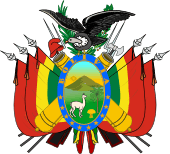Environmental issues in Bolivia
Major environmental issues in Bolivia include managing its forests, preserving the country's levels of biodiversity, maintaining ecologically important protected areas, coping with the effects of climate change, and dealing with the environmental consequences of agriculture, mining, oil and gas development, and transportation infrastructure.[1][2] Bolivia’s history of slash-and-burn agriculture, overgrazing, and industrial pollution has caused significant concern among environmentalists. Soil erosion, made worse by seasonal flooding, and contaminated water supplies are Bolivia’s most pressing environmental problems. The National Service for Protected Areas, established in 1998, currently manages 21 protected areas.
Deforestation
Bolivia holds an important share of global forest cover. As of 2015, its primary forest cover was 36.2 million hectares, the 13th largest national area in the world and representing 2.8% of the worldwide total.[3] It is the country with the seventh largest amount of tropical rainforest. Overall, forests made up 51.4 million hectares, 46.8% of the country's total area, in 2013.[4] Both primary forest and overall forest cover have been declining in recent decades.
Bolivia has 7.7 percent of the Amazon rainforest within its borders.[5]
Annual deforestation averaged 173,994 hectares in net forest lost per year between 1990 and 2000, and 243,120 hectares per year between 2000 and 2010.[6]
| 1990 | 2000 | 2005 | 2010 | 2015 | ||
|---|---|---|---|---|---|---|
| Primary Forest | 40,804 | 39,046 | 38,164 | 37,164 | 36,164 | 2.8 |
| As reported to the Global Forest Resources Assessment.[3] | ||||||
| Forest Type | Area
(ha) |
Percent
of forest |
Percent
of Bolivia | |
|---|---|---|---|---|
| 1 | Amazon forest | 19,402,388 | 37.7 | 17.7 |
| 2 | Chaco forest | 9,098,162 | 17.7 | 8.3 |
| 3 | Chiquitano forest | 8,645,849 | 16.8 | 7.9 |
| 4 | Yungas forest | 6,565,994 | 12.8 | 6.0 |
| 5 | Tucumano forest | 3,322,885 | 6.5 | 3.0 |
| 6 | Flooded forest | 3,047,598 | 5.9 | 2.8 |
| 7 | Pantanal forest | 1,147,401 | 2.2 | 1.0 |
| 8 | Dry inter-Andean forest | 172,227 | 0.3 | 0.2 |
| 9 | Andean forest | 4,496 | 0.01 | 0.0 |
| Total forest, 2013 | 51,407,000 | 100 | 46.8 | |
| Source: MMAyA-OTCA, summarized by Andersen et al 2016:S1.[4] | ||||
References
- Programa de las Naciones Unidas para el Desarrollo en Bolivia. "Medio Ambiente y Energía: Enfoque". El PNUD en Bolivia (in Spanish). Retrieved 2017-08-13.
- Castro, Mónica; Ferrufino, Rubén; Taucer, Evelyn; Zeballos, Hernán (2014). El Estado del Medio Ambiente en Bolivia. La Paz, Bolivia: Fundación Milenio & Fundación Konrad Adenauer.
- Morales-Hidalgo, David; Oswalt, Sonja N.; Somanathan, E. (2015-09-07). "Status and trends in global primary forest, protected areas, and areas designated for conservation of biodiversity from the Global Forest Resources Assessment 2015". Forest Ecology and Management. Changes in Global Forest Resources from 1990 to 2015. 352: 68–77. doi:10.1016/j.foreco.2015.06.011. ISSN 0378-1127.
- Andersen, Lykke E.; Doyle, Anna Sophia; Granado, Susana del; Ledezma, Juan Carlos; Medinaceli, Agnes; Valdivia, Montserrat; Weinhold, Diana (2016-03-18). "Net Carbon Emissions from Deforestation in Bolivia during 1990-2000 and 2000-2010: Results from a Carbon Bookkeeping Model". PLOS ONE. 11 (3): –0151241. doi:10.1371/journal.pone.0151241. ISSN 1932-6203. PMC 4798530. PMID 26990865. Included in Supplemental Material S1.
- Coca-Castro, Alejandro; Reymondin, Louis; Bellfield, Helen; Hyman, Glenn (January 2013), Land use Status and Trends in Amazonia (PDF), Amazonia Security Agenda Project, archived from the original (PDF) on March 19, 2016, retrieved August 25, 2019
- Andersen, Lykke E.; Doyle, Anna Sophia; Granado, Susana del; Ledezma, Juan Carlos; Medinaceli, Agnes; Valdivia, Montserrat; Weinhold, Diana (2016-03-18). "Net Carbon Emissions from Deforestation in Bolivia during 1990-2000 and 2000-2010: Results from a Carbon Bookkeeping Model". PLOS ONE. 11 (3): –0151241. doi:10.1371/journal.pone.0151241. ISSN 1932-6203. PMC 4798530. PMID 26990865. Table 6.
